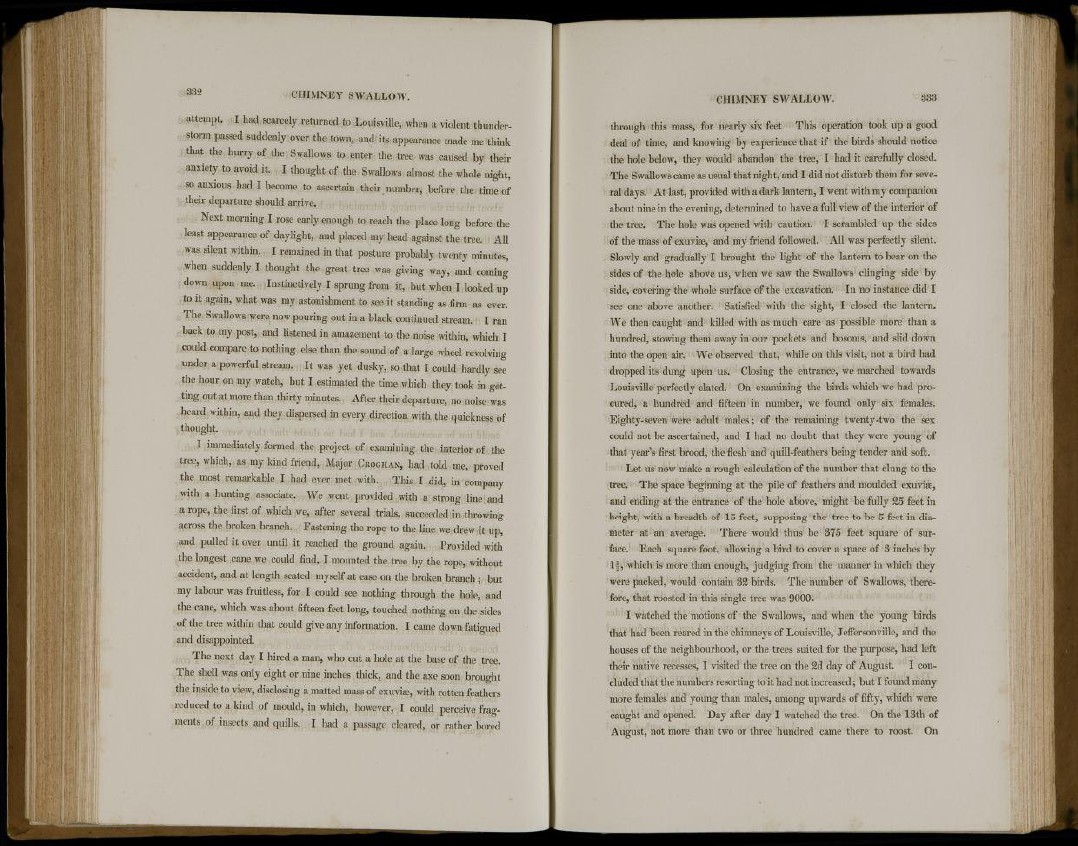
attempt. I had scarcely returned to Louisville, when a violent thunderstorm
passed suddenly over the town, and its appearance made me think
that the hurry of the Swallows to enter the tree was caused by their
anxiety to avoid it. I thought of the Swallows almost the whole night,
so anxious had I become to ascertain their number, before the time of
their departure should arrive.
Next morning I rose early enough to reach the place long before the
least appearance of daylight, and placed my head against the tree. All
was silent within. I remained in that posture probably twenty minutes,
when suddenly I thought the great tree was giving way, and coming
down upon me. Instinctively I sprung from it, but when I looked up
to it again, what was my astonishment to see it standing as firm as ever.
The Swallows were now pouring out in a black continued stream. I ran
back to my post, and listened in amazement to the noise within, which I
could compare to nothing else than the sound of a large wheel revolving
under a powerful stream. It was yet dusky, so that I could hardly see
the hour on my watch, but I estimated the time which they took in getting
out at more than thirty minutes. After their departure, no noise was
heard within, and they dispersed in every direction with the quickness of
thought.
I immediately formed the project of examining the interior of the
tree, which, as my kind friend, Major CHOGHAN, had told me, proved
the most remarkable I had ever met with. This I did, in company
with a hunting associate. We went provided with a strong line and
a rope, the first of which we, after several trials, succeeded in throwing
across the broken branch. Fastening the rope to the line we drew it up,
and pulled it over until it reached the ground again. Provided with
the longest cane we could find, I mounted the tree by the rope, without
accident, and at length seated myself at ease on the broken branch ; but
my labour was fruitless, for I could see nothing through the hole, and
the cane, which was about fifteen feet long, touched nothing on the sides
of the tree within that could give any information. I came down fatigued
and disappointed.
The next day I hired a man, who cut a hole at the base of the tree.
The shell was only eight or nine inches thick, and the axe soon brought
the inside to view, disclosing a matted mass of exuviae, with rotten feathers
reduced to a kind of mould, in which, however, I could perceive fragments
of insects and quills. I had a passage cleared, or rather bored
through this mass, for nearly six feet This operation took up a good
deal of time, and knowing by experience that if the birds should notice
the hole below, they would abandon the tree, I had it carefully closed.
The Swallows came as usual that night, and I did not disturb them for several
days. At last, provided with a dark lantern, I went with my companion
about nine in the evening, determined to have a full view of the interior of
the tree. The hole was opened with caution. I scrambled up the sides
of the mass of exuvise, and my friend followed. All was perfectly silent.
Slowly and gradually I brought the light of the lantern to bear on the
sides of the hole above us, when we saw the Swallows clinging side by
side, covering the whole surface of the excavation. In no instance did I
see one above another. Satisfied with the sight, I closed the lantern.
We then caught and killed with as much care as possible more than a
hundred, stowing them away in our pockets and bosoms, and slid down
into the open air. We observed that, while on this visit, not a bird had
dropped its dung upon us. Closing the entrance, we marched towards
Louisville perfectly elated. On examining the birds which we had procured,
a hundred and fifteen in number, we found only six females.
Eighty-seven were adult males; of the remaining twenty-two the sex
could not be ascertained, and I had no doubt that they were young of
that year's first brood, the flesh and quill-feathers being tender and soft.
Let us now make a rough calculation of the number that clung to the
tree. The space beginning at the pile of feathers and moulded exuviae,
and ending at the entrance of the hole above, might be fully 25 feet in
height, with a breadth of 15 feet, supposing the tree to be 5 feet in diameter
at an average. There would thus be 375 feet square of surface.
Each square foot, allowing a bird to cover a space of 3 inches by
If £ which is more than enough, judging from the manner in which they
were packed, would contain 32 birds. The number of Swallows, therefore,
that roosted in this single tree was 9000.
I watched the motions of the Swallows, and when the young birds
that had been reared in the chimneys of Louisville, Jeffersonville, and the
houses of the neighbourhood, or the trees suited for the purpose, had left
their native recesses, I visited the tree on the 2d day of August. I concluded
that the numbers resorting to it had not increased; but I found many
more females and young than males, among upwards of fifty, which were
caught and opened. Day after day I watched the tree. On the 13th of
August, not more than two or three hundred came there to roost. On